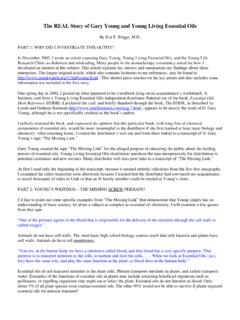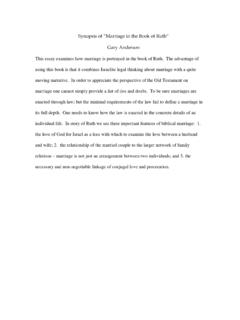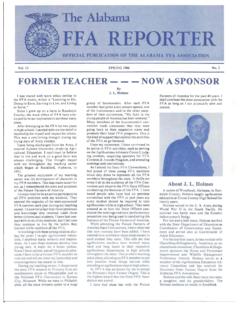Transcription of Weasel Comparison Chart handout - wiwildlife
1 P Popp, WWRA presentation The Care and Keeping of Orphaned Weasels, February 2016 Page | 1 FAMILY: Mustelidae Also M. (Putorius) nigripes (black footed ferret) Least Weasel Mustela nivalis (Previously M. rixosa) Short-tailed Weasel Mustela ermine Long-tailed Weasel Mustela frenata Mink Mustela (Lutreola) vison Length, total Length, head+body Length, tail tail, relative to body Weight (smaller in northern parts of range) 6 8 5 7 1; 5 10 2 1 10 15% 37 50 g larger (2x?) than 7 13 5 11 1; 7 13 2 1 3 ~ 25% 45 182 g 2x size of 11 22 7 15 1; 9 10 2 3 6 50 100% 85 267 g 2x size of = 111g; 195g; juv 162 g 19 22 13 14 1; 14 22 2 6 7 50% 700 1,600 g larger than Coloration Tiny.
2 Dark brown above, white below. Tail very short and all brown. Feet white. Turns white in winter in the northern part of range. Often has an individually distinct brown spot on chest at 18 days which disappears after 4 months of age (when mature? after first adult molt?). Dark brown above, white below; brown tail with black tip. Feet white. Turns white in winter w/black tail tip in the northern part of range. No chest markings. Brown above, white to deep yellow below. Brown tail with black tip. Feet brown-ish. Tail often equal to head+body length. Turns white in winter w/black tail tip in northern part of range.
3 Some individuals have spot/s on chest developing at 35 days. Lustrous chocolate brown to black fur, white spotting on chin and throat. Tail long and somewhat bushy. (note: no white underparts) Breeding Mates year round with no delayed implantation; young born after =35 day gestation. are sexually mature at 8 months and at 4 months although they seldom breed in their birth year. Mates in June-July with delayed implantation. Young are born following April after 27 day active gestation are sexually mature 2nd year but is often bred by same male breeding with her mother, giving birth the following spring.
4 Mates mid-summer with delayed implantation; young are born the following spring after 23-24 day active gestation. mature during 2nd summer; at 3-4 months. Mates January April, may have delayed implantation. Males may mate with several females but eventually lives with one and helps with the young. Primary references: 1 National Audubon Society Field Guide to Mammals, 1996 rev; 2 Mustelid (Mustelidae) Care Manual, Association of Zoos and Aquariums, July 2008, revised January 2010; 3 American Weasels, E. Raymond Hall, August 2015 (written over the past 25 yrs.); 4 The Least Weasel Mustela nivalis Linnaeus, Developmental Biology in Comparison With Other North American Mustela, Biological Series Volume 4, Number 7, Publications of the Museum, Michigan State University, Gary A Heidt, April 1970 5 East and Lockie, Edinburgh P Popp, WWRA presentation The Care and Keeping of Orphaned Weasels, February 2016 Page | 2 Least Weasel Mustela nivalis (Previously M.)
5 Rixosa) Short-tailed Weasel Mustela ermine Long-tailed Weasel Mustela frenata Mink Mustela (Lutreola) vison Litter, size & description Larger litters are more common in the northern part of range. Up to 3 litters per year of 1-14 young ( =4-5); usually born in early spring and mid-summer, often in abandoned burrows of another animal. Documented births (in the wild) in every month. 1 litter of 4-9 young ( =6); born blind with fine hair. Mane present at birth and continues to develop as fur comes in (14 days). Male and female may care for the young. Litter size =6-7 but wide range (<4 to >9) Born blind and nearly naked.
6 Only the female cares for the young. Young disperse at 7-8 weeks, at which point the are already larger than their mother. Litter of 1 10 ( =4-5) born blind and [nearly] naked in fur-lined nest in April or May. Weight at birth = g = g ~3 g 8-10 g Hair appears @ 4 days covered with fine white Fine white hair within first day. Born with a few sparse long white hairs on back and head. >1 day covered with fine white Begins to crawl 4 days early 14 days ( ), 14-21 days ( ) Brown dorsal fur appears 18 days Hair comes in fast; at 18 days has brown/white coloring.
7 21 days @7 days demarcation apparent; @14-21 days heavy mane contrasts with scantily white furred animal 4 28-35 days @ 3 weeks dark line of demarcation and tail tip is black. @ 5 weeks brown top and bottom light (white yellow/tan) Varies with color phase Ears open 21-28 days4 35 days4 28 days4 ? Eyes open 26-30 days4 35 days (blue at first) 4 36-41 day, before 5 35-37 days4 ? Black tail tip appears N/A 45 days (in England)4 21 days4 N/A Weaning Continues limited nursing until dispersal @14 days begins to suck and chew on pieces of mouse; Eating solid food > 18 days4 Weaning Initiated at 32 days and continues until 42-56 days4 Consumes meat at 21-28 days and by 35 days is eating >50% BW in meat (still continues to nurse until dispersion)4 Juveniles begin hunting at 10-12 weeks.
8 Consumes meat at 21 days and by 36 days are eating to nearly their own weight in meat/day4 Weaned at 28-35 days. 5-6 weeks Young remain with their other until the family disperses in early fall. P Popp, WWRA presentation The Care and Keeping of Orphaned Weasels, February 2016 Page | 3 Least Weasel Mustela nivalis (Previously M. rixosa) Short-tailed Weasel Mustela ermine Long-tailed Weasel Mustela frenata Mink Mustela (Lutreola) vison First kills prey 6-7 weeks 80 days (Europe) Growth complete Disperses at 13-18 weeks Summer>Fall>Winter/Spring Reaches adult length at 8 weeks and adult weight at 12-15 weeks.
9 Slows growth 8 wks; both sexes at adult size 12 wks. Consuming 28-38% BW/day Kills prey by =========> Killing move is instinctive but efficiency improves with training/experience. Biting back of the neck. Prefers head/brains, inner organs, muscles. Biting back of the neck. Prefers head/brains, inner organs, muscles. Biting back of the neck. Prefers head/brains, inner organs, muscles. Biting back of the neck. Marks hunting territory with fetid musk > skunk Activity Hunting is a learned behavior. Day and/or night, all seasons. Very rarely seen as they stay undercover. Home range < 2 acres.
10 Active both day and night. Hunts mainly on the ground but can climb and even pursues prey into the water. Most wide-spread carnivore in the Western Hemisphere. Active both day and night. Hunts mainly on the ground but can climb. Able to dive to a depth > 16 feet, the mink is an accomplished swimmer and spends much time hunting in ponds and streams. Adapts activity to prey. Vocalization Murmurs. When disturbed may give a shrill squeaking call, and may also hiss when threatened. Grunts, murmurs, hisses, chatters, shrill (and very loud) alarm call Screech and squeal, rapid trill, and purr when content.




